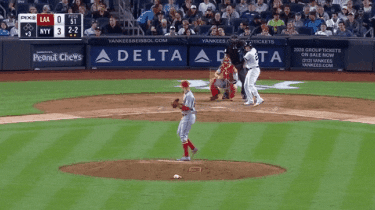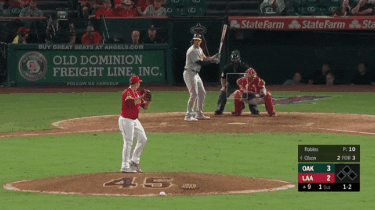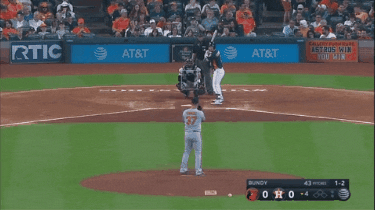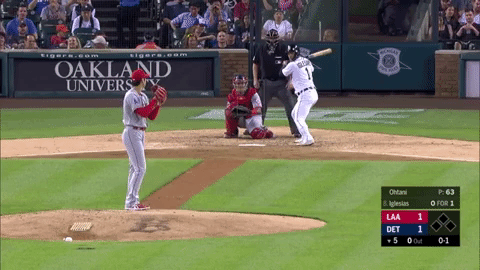I’m not going to lie: I had an absolute blast putting this article together.
You’re probably wondering how or why I invested this much time into finding the best pitches on this Angels staff. Many of you, like myself, are likely terrified that the pitching may once again fail the Angels in 2020. But for the Angels to get back into the playoffs, they’re going to need their pitchers to have their best stuff on display this season (obviously). Hope springs eternal and being the optimist I am (and uber Angels and baseball nerd), I decided to rank the best pitches on this staff.
Here’s what I did. I spent a bulk of my time at Baseball Savant crunching the numbers, charts, and videos to put this together. Thanks to Baseball Savant’s Statcast database, we can analyze pretty much everything about individual pitches. In this piece, I’m going to rank the top 10 Angels pitches based on a variety of statistics, videos, and trends. A quick primer on some numbers I will utilize in each blurb below the pitch (reflects 2019 numbers):
- xwOBA against: Short for Expected Weighted On-Base Average. Rather than simply look at an outcome, xwOBA instead looks at the quality and amount of contact. For these individual pitches, xwOBA gives us an idea of the quality and quantity of contact against each pitch.
- Whiff percentage: Percentage of swinging-strikes per swing. The league-average whiff percent is generally between 20-25%.
- Average exit velocity against: The average velocity each batted ball was hit against the pitch.
- Vertical/horizontal movement break percentage vs average: I promise this isn’t as complicated as it sounds. Statcast leaderboards allow you to see the vertical & horizontal movement of each pitch. In addition, they compare to the league-average movement of that particular pitch. This helps compare the movement of each pitch against the league average pitch.
Honorable Mentions
- Cam Bedrosian’s slider: This was the pitch I struggled the most with leaving off the list. It’s one of the biggest vertically-breaking sliders (45 inches) in baseball and Bedrosian finally started throwing the slider more (50.9 percent) than his fastball (47.8%) last year. The results, however, haven’t quite matched the nastiness of the pitch (.257 xwOBA last year).
- Shohei Ohtani’s curveball: He only threw the pitch 56 times in 2018 but it’s a nasty pitch that produced nasty results. The pitch was top-20 in both vertical break (66.7 inches) and active spin rate (90.7%). Hitters whiffed on 40 percent of their swings. If he throws it more this year, it’s easily a top-10 pitch on this staff.
- Shohei Ohtani’s fastball: Ohtani’s 95th percentile fastball velocity helps set up his other elite pitches but the poor spin, active spin, and command dragged the pitch down in 2018 (.424 xwOBA).
- Griffin Canning’s curveball: This pitch has a good argument for making the list but we don’t know if we’ll see it in action this year (Angels pitchers and their damn elbow injuries). It’s below-average in terms of spin and vertical movement but above-average in every other way (velocity, horizontal movement, whiff %).
- Justin Anderson’s slider: The dominant slider he flashed in 2018 (.194 xwOBA) regressed in a major way in 2019 (.274 xwOBA). That will happen when you throw it slower, spin it slower and get less movement.
10. Dylan Bundy’s change-up
- xwOBA: .300
- Whiff Percentage: 32.5%
- Average Exit velocity: 87.3 mph
- Vertical movement break percent vs avg: 2%
- Horizontal movement break percent vs avg: minus 3%

2019 was a coming-out party for Bundy’s change-up, a pitch that produced more whiffs (32.5 percent) and grounders (57.7 percent) than ever before. Hitters chased the change-up more (43.5 percent) and rarely barreled it up (2.7 percent). This success stemmed from Bundy altering the shape on the pitch. Bundy’s change-up had a more vertical break (32.7 inches) and saw a near-200 RPM drop in spin rate (less spin is good for change-ups). Bundy threw the pitch more than ever (17.4 percent), mainly against lefties (76.4 percent) as an out pitch. I ranked this pitch in the top 10 because it’s trending in the right direction and he’s throwing it exceptionally well already this spring. Expect Bundy to throw this pitch just as much, if not more, in 2020.
9. Félix Peña’s slider
- xwOBA: .232
- Whiff Percentage: 46.2%
- Average Exit velocity: 85.9 mph
- Vertical movement break percent vs avg: 1%
- Horizontal movement break percent vs avg: minus 72%

Peña has produced monstrous results with the slider despite the pitch offering nothing exciting in terms of movement, spin or velocity. The pitch is average in terms of vertical movement and spin and gets almost no horizontal movement (1.7 inches). In many ways, it acts like a curveball and is very different than the modern-day slider that features more horizontal movement. His pitch tunneling numbers at Baseball Prospectus don’t suggest that he is deceptive with it. Despite all of this, Peña has a near-50 percent whiff rate on the pitch over the last two years. He kills righties with it and is perfectly capable against lefties. So where does all the success come from? His strong command of the pitch, evidenced by his 2019 slider heat map at Baseball Savant, is the likely culprit for the success.
8. Noé Ramirez’s change-up
- xwOBA: .228
- Whiff Percentage: 34%
- Average Exit velocity: 87.2 mph
- Vertical movement break percent vs avg: 22%
- Horizontal movement break percent vs avg: minus 18%

Ramirez’s change-up is a huge reason for his recent success and reliability over the last two seasons. Ramirez has had middling-to-poor results on his fastball and curve, leading to more reliance on his change-up. He threw the change-up more than ever before (34.3 percent) and for good reason. The pitch produced a strong whiff rate (34 percent), groundball rate (52.2 percent) and barrel rate (6 percent). This power change-up is so darn effective because it’s only about 5 mph slower than the fastball but is one of the biggest vertical breakers among all change-ups. The 43.6 inches of break was the fourth-highest figure among all change-ups last season. Ramirez will likely continue to rely on this pitch heavily as he logs a ton of innings out of the bullpen.
7. Andrew Heaney’s curveball
- xWOBA: .282
- Whiff percent: 40.9%
- Exit velocity: 88 mph
- Vertical movement break percent vs avg: minus 7%
- Horizontal movement break percent vs avg: minus 34%

The next two pitches on this list are outliers in terms of how they operate to the norm. Heaney throws his curve fairly hard (79.4 mph) but he spins it at an average rate with below-average vertical and horizontal movement. Despite its’ characteristics, Heaney’s curveball has produced monstrous results. In his career, his curveballs have generated a 42 percent strikeout rate and a 3 percent walk rate. Heaney not only kills lefties with the pitch (53.8 percent whiff rate in 2019) but he uses it well well against righties (35.5 percent). Heaney has superb command of the pitch, as he is able to get lefties to chase the pitch and bury it on the back feet of righties. His 2019 curveball heat map on Baseball Savant backs this up.
6. Patrick Sandoval’s change-up
- xWOBA: .257
- Whiff percent: 49.6%
- Exit velocity: 82.7 mph
- Vertical movement break percent vs avg: minus 4%
- Horizontal movement break percent vs avg: minus 7%

Sandoval has an odd but effective change-up. The pitch has average velocity (83.6 mph) and below-average vertical (30.2 inches) and horizontal (12 inches) movement. Sandoval gets tons of fly balls (32.3 percent) but most of it is weak contact (82.7 percent). Despite its’ unusual characteristics, the pitch was deadly in 2019. Sandoval ran a near-50 percent whiff rate on the pitch and did not allow a single barrel. More intriguing perhaps is Sandoval’s 46.4 in-zone whiff percentage, an absurdly high rate for any pitch in the zone. Sandoval’s change-up does not behave like a prototypical version (it even cuts at times) but it works. Using it strictly against righties (90 percent), the pitch may be a platoon split equalizer which gives Sandoval a legit shot to stick as a starter. If he commands it like he did last year (check his heat map here), good things may be in store.
5. Hansel Robles’ change-up
- xWOBA: .182
- Whiff percent: 36%
- Exit velocity: 86 mph
- Vertical movement break percent vs avg: minus 2%
- Horizontal movement break percent vs avg: minus 8%

Robles completely revamped his change-up in 2019, showing a different look in terms of speed, spin, and movement. He threw the pitch harder than ever (89.5 mph), spun it slower (less spin is good for change-ups) and had more vertical movement than ever (28.7 inches). In conjunction with changing the pitch, Robles threw it a career-high 254 times with the results to show. Robles not only missed bats with the pitch (36 percent whiff rate) but also posted a gaudy 70.5 percent groundball rate. The pitch blends perfectly with the fastball, coming from the same arm slot and arm action but with a 7-10 mph drop and 15 more inches of vertical break. Speaking of Robles’ fastball…
4. Hansel Robles’ fastball
- xWOBA: .268
- Whiff percent: 25.6%
- Exit velocity: 88.6 mph
- Vertical movement break percent vs avg: 13%
- Horizontal movement break percent vs avg: 41%

Robles has one of baseball’s most disgusting fastballs for various reasons. The pitch took a significant step forward in 2019 due to a noticeable bump in velocity. His 97.2 mph average fastball velocity last season was in the 96th percentile and a huge jump from his 95.9 mph figure in 2018. Velocity isn’t the pitches’ only redeeming quality though. The fastball’s spin ranks in the 86th percentile and its’ active spin percentage of 94.7 percent was a top-20 figure last year. Essentially, this means that Robles throws his fastball incredibly hard with nearly perfect efficient spin to generate whiffs. The pitch not only features the perfect backspin to miss bats but it also had the added element of strong horizontal movement (12.8 inches). This is truly one of the best fastballs in the game and helps set up his superb change-up and strong slider.
3. Dylan Bundy’s slider
- xWOBA: .218
- Whiff percent: 47.9%
- Exit velocity: 84.4 mph
- Vertical movement break percent vs avg: 5%
- Horizontal movement break percent vs avg: minus 34%

Bundy’s slider has undergone changes in recent years and it was noticeably different in 2019. The pitch had a near-100 RPM boost (up to 2573) and more vertical break than ever (44.6 inches). Bundy isn’t throwing the pitch any harder but he’s spinning it harder while swapping out horizontal movement for vertical movement. In many ways, this slider operates like a hard curveball, much like Peña’s slider does. The pitch works for Bundy though, evidenced by his insane 47.9 whiff percentage and strong 52.4 percent groundball rate. With two potentially elite pitches, Bundy should start throwing his slider and change-up more this season, which I discussed in-depth here.
2. Shohei Ohtani’s slider
- xWOBA: .205
- Whiff percent: 39.8%
- Exit velocity: 78.2 mph
- Vertical movement break percent vs avg: 3%
- Horizontal movement break percent vs avg: 139%

Oh boy, are we excited to see this again in 2020. Shohei Ohtani owns the top two spots on this list. First up is Ohtani’s slider which is one of the biggest horizontal breakers in baseball. Among pitchers who threw at least 100 pitches in 2018, Ohtani’s slider was the third-best in horizontal movement vs average (8.8 inches) and seventh in percentage break vs average (139%). In comparison to Dylan Bundy’s slider, Ohtani’s has a ton of horizontal movement that is more in line with the modern slider. The pitch has poor spin (2319 RPM) but Ohtani gets the most out of it with a 69.4 active spin percentage (top-20 figure). Hitters whiffed on 39.8 percent of their swings against Ohtani’s slider and when they did make contact, it was rather poor (78.2 mph). This is a legitimately elite pitch, just like the next pitch that Ohtani has.
1. Shohei Ohtani’s splitter
- xWOBA: .157
- Whiff percent: 55.8%
- Exit velocity: 89.4 mph
- Vertical movement break percent vs avg: 8%
- Horizontal movement break percent vs avg: minus 46%

Ohtani’s splitter is legitimately one of the best pitches in all of baseball. The sheer velocity (87.3 mph) and late vertical drop (66.7 inches) makes it one of the most unhittable pitches on the planet. Ohtani’s fastball and splitter come from the same release point and arm action, making it nearly impossible to distinguish the two pitches. This led to gaudy numbers in his rookie season in 2018. 59 plate appearances ended with an Ohtani splitter. Just two hitters had hits against it and 35 hitters struck out. Luckily for the Angels and baseball fans, this pitch will be back in action very soon.
So you’re saying Ohtani has some pretty good pitches?
Great work Brent. Ohtani’s Slider looks more like a curve in that video (both in action and delivery)- either way – it’s filthy. I seem to remember him having a harder slider with more side break too. Does he throw it in different ways? Is there a wide velocity range on his slider?
He has a unique ability to manipulate the ball in different ways. That specific slider had 18 inches of horizontal movement, which is absurd even for his standards (his average was 15 inches, which is a ton). His slider averaged 81.5 mph so this specific one was a bit slower but I found several other sliders with similar velocities.
Where was Suarez’s change-up?
Hitters slugged .445 against his change-ups last year and the pitch was below average in terms of movement. I certainly think it’s a pitch that could crack the list this year but he needs to clean up the command of the pitch.
Thanks for the article and gifs!
Looking forward to seeing all thise balls in action soon.
Thank you! We’re all excited for these pitches to be in action in real games.
Best article of the short life span of CTPG, research and GIF’s awesome and appreciated making this a great read. Boy did l learn a lot here. Great job Brent, this was a fun in comparing these guys.
Thanks for the kind words and thanks for reading! Glad to have you on board.
Very fun to read. Cool with all the gif’s. So many of them are off speed. Makes me think Eppler’s love of the radar gun is getting in his way at times. I know off speed stuff plays off the fastball, but outside of Ohtani none of these guys really bring it.
Thanks, Jeff! I do think Eppler looks for a lot of other factors (spin rate, obviously) outside of sheer fastball velocity.
And Robles does have heat.
Just throw those pitches over and over again! What could go wrong? 😉
Funny stuff
This was really fun to read!!
Thanks, Rahul!!
What an enjoyable article to take in! It’s great having a gif of each pitch as well as comparing the same pitches between two different pitchers on the same staff.
I dunno what to expect out of Ohtani this season after a year away from throwing the ball. I love what I seen out of Ohtani in 2018, but I’m always wary of reproducing similarly immediately after a year off of any injury.
Much-appreciated! Thanks for reading. I also don’t really know what to expect from Ohtani but they desperately need some quality innings from him.
Excellent work! Regarding Cam’s slider, I think the main problem is his command of it. Early last year I reviewed a bunch of different Cam sliders and they were all over the place in location and break amount.
Thanks, Jessica! I had a hunch that the command was an issue. If he can learn how to bury that pitch a bit, he could take a huge step forward.
Ohtani San! Strike some dudes out!